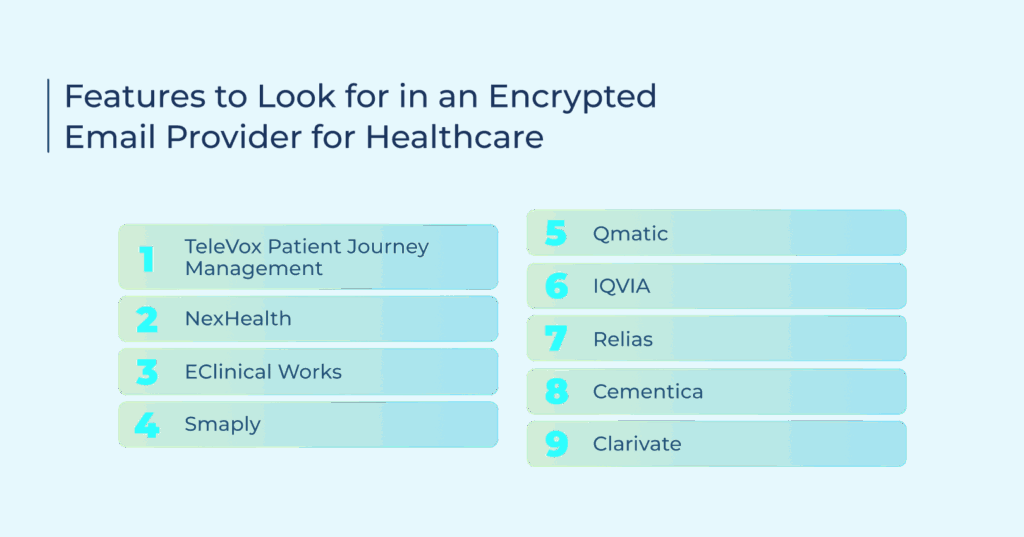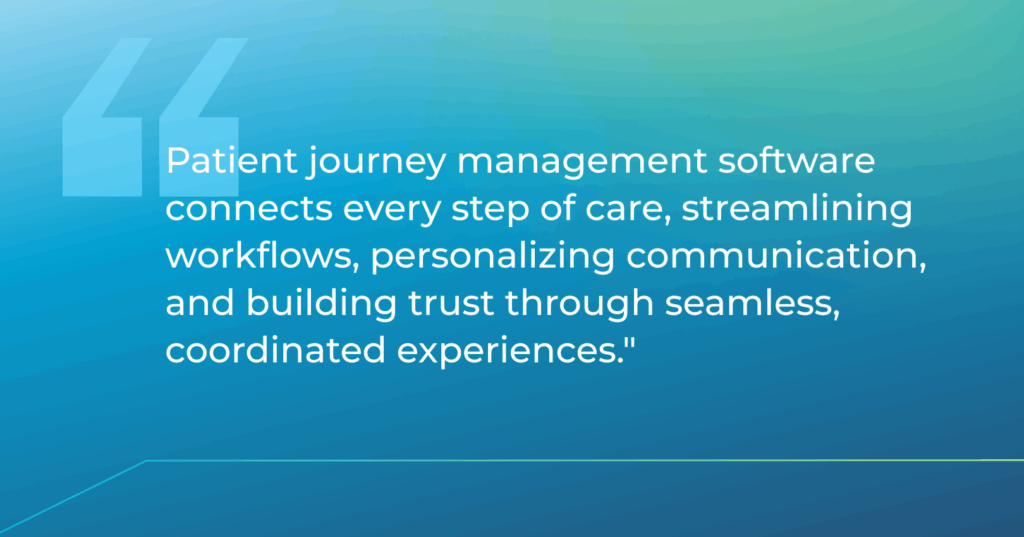As we approach the end of 2023, healthcare providers continue to face an array of…

Best Patient Journey Management Software to Improve Patient Experience
Every patient journey comprises several small but critical moments. When these moments fall out of sync, patients start to lose trust in their healthcare system. Your patient journey management software plays a major role here in connecting all the pieces. It provides the tools to coordinate care, improve communication, and keep workflows running smoothly. The result is a patient experience that feels connected from start to finish.
What Does Patient Journey Management Software Do?
Patient journey management software basically watches over patients from the moment they book an appointment until they’re completely done with treatment.
Most healthcare software are only able to do a single task. However, a patient experience platform connects everything together so your staff can see where each patient is in their care journey and what needs to happen next.
- Patients get texts or emails the second their lab results come in.
- The system prompts patients about upcoming appointments so they actually show up.
- Patients can book appointments and pay bills from their phone anytime.
- The staff don’t have to manually confirm every appointment or check insurance.
- You can see exactly where patients get stuck.
- You get numbers that show you what’s working and what’s making patients frustrated.
9 Best Patient Journey Management Solutions for Healthcare Providers
Patient journey management software helps healthcare providers coordinate every step from that first phone call to follow-up appointments months later. The platforms below handle different aspects of patient care coordination in that regard. Here’s what each one actually does and whether it might work for your practice.

1. TeleVox Patient Journey Management
TeleVox builds patient journey management software that centralizes communications across phone, text, and web chat. Their platform connects directly with your EHR to automate routine tasks and patient interactions.
SMART Agent, TeleVox’s AI-powered virtual assistant, acts as a healthcare-specific concierge that answers common questions, shares resources like intake forms, and supports self-service options such as billing inquiries and prescription refill requests.
Pros:
- AI-driven SMART Agent reduces call volume by handling common patient requests.
- SMART SMS enables quick, two-way appointment management through text.
- EHR integration ensures data remains synchronized across platforms.
- Multi-channel outreach improves patient engagement and accessibility.
Cons:
- Large feature set might overwhelm smaller practices with basic communication needs.
- Costs vary based on scale and selected features.
- Advanced capabilities like live agent support may add to overall expenses.
- Staff adoption may take some adjustment to new digital workflows.
2. NexHealth
NexHealth connects directly to your existing practice management system. Their 1-Click Booking feature allows patients to reschedule or book follow-up appointments with minimal hassle. Reminders are sent out automatically, payments are processed, and feedback is collected following every visit. All of this syncs back to your practice management software automatically without anyone on your staff having to lift a finger.
Pros:
- No double-booking because it shows your actual schedule in real time.
- Patients can handle most tasks themselves, reducing phone calls to your office.
- Digital forms speed up check-ins and reduce waiting room congestion.
- Reports show you exactly where patients drop off in your booking process.
Cons:
- Setup requires working with your current software vendor to establish the connection.
- Pricing varies widely depending on your practice size and needs.
- Staff needs training to use all the features effectively.
- Some older practice management systems may have limited integration options.
3. eClinical Works
eClinicalWorks integrates EHRs with patient journey software features within a single system. Rather than using individual platforms for clinical notes, scheduling, and communication with patients, everything runs through their cloud-based platform.
You get patient portals in which patients are able to message providers, see test results, and request prescription refills. Their telehealth feature also allows you to do video sessions without any additional software.
Pros:
- One login gives you access to everything.
- Cloud access means you can check patient information from anywhere.
- Templates for different specialties save time on documentation.
- Built-in telehealth means no need for additional video tools.
Cons:
- Learning the entire system takes significant time and training.
- Smaller practices may find the features overwhelming.
- Performance can slow down during busy periods.
- Moving your existing data into the system requires careful planning.
4. Smaply
Smaply takes a different approach than most patient experience platforms. It helps you map out and improve your current processes instead of just managing patient interactions.
You create visual maps showing each step patients take, from first contact through treatment and follow-up. The platform includes templates for common healthcare scenarios and collaboration tools for team input. It connects to feedback systems so you can see where patients get frustrated or confused.
Pros:
- Visual maps make it easy to see and share patient flow problems with your team.
- Multiple people can contribute ideas and feedback on journey improvements.
- Ready-made templates help you get started quickly.
- Patient feedback ties directly to specific journey steps.
Cons:
- Only handles planning and analysis, not actual patient communications.
- You’ll still need other systems for scheduling, messaging, and payments.
- Team members need to learn journey mapping concepts.
- Advanced features cost extra and may not be worth it for smaller practices.
5. Qmatic
Qmatic is built to manage patients after they arrive at your facility. It works to optimize your patient flow to reduce wait times.
Patients can check in using kiosks or their mobile phones. Since the system is always tracking your queues, even if the room gets crowded, an alert is sent to the staff to make suitable adjustments. Qmatic also integrates with your existing appointment system to help coordinate scheduled visits with walk-in patients.
Pros:
- Mobile check-in appeals to patients who prefer self-service options.
- Real-time data helps you adjust staffing based on patient volume.
- Works with your current appointment system without major changes.
Cons:
- Mainly handles the in-office flow rather than the complete patient journey.
- Digital displays and kiosks require upfront hardware investment.
- Limited communication features beyond check-in notifications.
- May need facility modifications to install displays and kiosks properly.
6. IQVIA
IQVIA works more like a healthcare data company than a traditional patient journey management software provider. They collect and analyze massive amounts of healthcare information to help enterprises improve treatment outcomes.
Their platform combines patient data from multiple sources, tracks clinical trial results, and provides market research for healthcare products.
Pros:
- Access to extensive healthcare databases provides deep patient insights.
- Advanced analytics support complex research and decision-making.
- Established connections with major healthcare organizations worldwide.
Cons:
- Built for enterprises, not small health systems.
- Licensing is too expensive.
- Requires data science expertise for the best results.
- Focuses on research and analysis rather than direct patient care.
7. Relias
Relias doesn’t directly manage patient interactions but supports patient experience platform goals through staff training. They offer online courses, compliance tracking, and competency assessments through thousands of modules on clinical skills, patient communication, safety, and regulatory standards.
Pros:
- Comprehensive training library covers most healthcare specialties and topics.
- Automated tracking simplifies compliance reporting.
- Skills assessments highlight training gaps.
- Mobile access enables learning on the go.
Cons:
- Doesn’t handle patient scheduling, communications, or journey management.
- Benefits show up indirectly through improved staff performance.
- Still need separate systems for actual patient interactions.
- Hard to measure direct impact on patient satisfaction or outcomes.
8. Cementica
Cementica builds customer journey tools that healthcare organizations can adapt for patient communication. Their platform automates messaging workflows and tracks how patients respond to different outreach efforts.
Pros:
- Reaches patients through their preferred communication channels.
- Automation reduces manual work for front office staff.
- Analytics show which messages work best for different patient groups.
Cons:
- Generic platform requires customization for healthcare-specific workflows.
- May lack built-in HIPAA compliance features required for patient communications.
- Setup requires technical knowledge to configure healthcare-appropriate workflows.
- Limited pre-built integrations with healthcare management systems.
9. Clarivate
Clarivate specifically serves pharmaceuticals and research institutions. It helps collect data to improve the chances of successful regulatory approvals via its clinical trial databases, drug development analytics, and market research tools.
Pros:
- Comprehensive regulatory and clinical trial databases enable more confident choices.
- Global regulatory intelligence helps navigate complex approval processes.
- Strong relationships with pharmaceutical and biotech companies.
- Powerful search capabilities for research and development teams.
Cons:
- Designed for pharmaceutical research, not patient experience management.
- High costs limit access to large organizations with substantial research budgets.
- Complex interface requires specialized training to use effectively.
- No patient communication or direct care coordination features.
How to Choose the Right Patient Journey Management Software
Most practices make the mistake of buying software based on feature lists instead of thinking about their day-to-day reality. Here’s what actually matters:
- Does it play nice with your existing tech? Your patient experience platform has to connect with your EHR and whatever billing system you’re already using. If it doesn’t sync properly, your staff will spend their day entering the same information twice. Ask for a demo that shows real data flowing between systems, not just screenshots.
- Can patients actually use it? Look for patient journey software that normal people can figure out without instructions. If your 70-year-old patients can’t book appointments online or your busy parents can’t fill out forms on their phones, the software is useless. Test it yourself before you buy it.
- Will it keep you out of legal trouble? Your platform needs HIPAA compliance, proper encryption, and audit trails that actually work. Don’t just take the vendor’s word for it; ask to see their compliance documentation. One data breach will cost you way more than buying secure software in the first place.
- Can you make changes when you need to? Pick patient journey management software that lets you modify workflows without calling tech support every time. Look for platforms where you can create custom forms and adjust automated messages yourself.
- Does it tell you what’s working and what isn’t? Your patient experience platform should show you real numbers about patient satisfaction, no-show rates, and where people drop out of care. Generic reports are worthless. You need data that helps you make specific improvements to your practice.
How a Journey Management Solution Can Improve Patient Experience
A patient journey management software transforms how healthcare providers interact with patients from first contact to follow-up care. Here are five ways these platforms make a real difference:
- Patients book their own appointments: Patient journey software puts scheduling power directly in patients’ hands. They can log in at midnight, pick their preferred time slot, and get confirmation instantly.
- Forms get done before patients walk in: Your patient experience platform sends intake forms straight to patients’ phones or computers. They fill everything out from their couch, not in your crowded waiting room. Staff already have the information loaded when patients arrive, so check-in takes seconds.
- Everyone stays in the loop without phone calls: Your software sends updates directly to patients when lab results come in or appointments get moved. Patients can message questions back without calling and interrupting someone else’s appointment.
- Each patient gets their own experience: The patient journey software remembers everything. For example, a patient might prefer large-print forms, or another who prefers evening appointments. The staff see these notes immediately, so nobody has to repeat their preferences every single visit.
- Care continues even after patients leave: Your patient experience platform keeps working when patients go home. It sends medication reminders to their phone, checks how they’re feeling with quick surveys, and automatically books their next appointment.

How TeleVox Helps in Effective Journey Management of Patients
Consider a patient who reaches out late at night with a question and actually gets an answer right away. That’s TeleVox in action.
With our AI-powered SMART Agent and SMART SMS, patients can handle common requests like scheduling an appointment, checking a bill, or requesting a prescription refill via text, call, or chat.
TeleVox works hand in hand with your EHR, making every interaction feel simple and connected. When patients need a form, they get it. When they’re unsure of the next step, the system points the way.
It’s a straightforward kind of support that keeps patients in the loop and frees your team to focus on what matters most: delivering care.
Ready to see how TeleVox can make each patient touchpoint smoother and more meaningful? Book a demo and see it in action.



